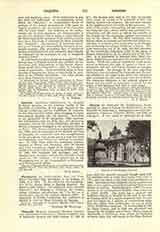

Caqueta, APOSTOLIC PREFECTURE OF, situated in South America on the southern border of the Republic of Colombia, in the angle formed by the Central Cordilleras and the Cordilleras del Caqueta, on the river Caqueta, which, after changing its name into Japura, empties into the Amazon. According to an agreement of December 27, 1902, between the Government and the Holy See, this prefecture comprises almost the entire Colombian province of Mocoa; it formerly belonged to the extensive Diocese of Pasto. The decree of erection is dated December 20, 1904, and the Capuchins of the Spanish province of Cataluna are entrusted with the evangelization of the aborigines, who as yet are in a very low state of civilization, some being even addicted to cannibalism. In 1906 there were two permanent mission-stations at Mocoa and Sibundoy, with 10 fathers and 3 lay brothers in charge of 14 chapels. About 12,000 converted Indians live among 40,000 heathens. In 1906, 245 baptisms, 130 marriages, and 118 funerals were recorded, and the five Catholic schools numbered 178 children. It is subject not to the Propaganda but to the Congregation of Extraordinary Ecclesiastical Affairs.
OTTO JERON

